
|   |

|   |
 e-mail: leelakaverivenkat@gmail.com Immersive cultural extravaganza blending art with scholarship in Ramayana Kalpavrksam Photos: G Muralidhar May 7, 2023 Ramayana Kalpavrksam, an immersive cultural experience spread over three days, held at Hyderabad's CCRT Campus, Madhapur, under the aegis of Shankarananda Kalakshetra and Natyarambha, was one of its kind. Curated by artist/scholar/administrator Ananda Shankar Jayant, who, for the best part of her life has presided with equal panache over the two very dissimilar worlds of bureaucracy and art, along with scholar Anupama Kylash as co-planner designing the morning talks, here was a cultural extravaganza, with the rare opportunity for listening to and interacting with brilliant minds, alongside being treated to rare and specific works of art - all inspired by the Ramayana. Like the proverbial Banyan tree with a spread, covering areas far beyond its place of birth, the Ramayana offshoots have spread far beyond our country - to South East Asia and other places, spouting varying expressions of culture. 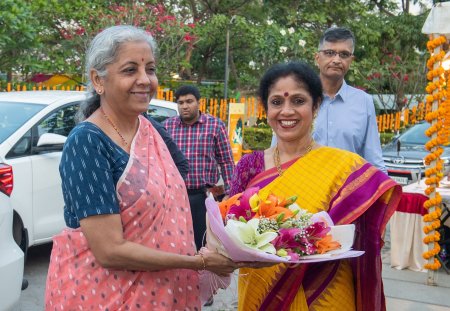 Nirmala Sitharaman and Ananda Shankar Jayant 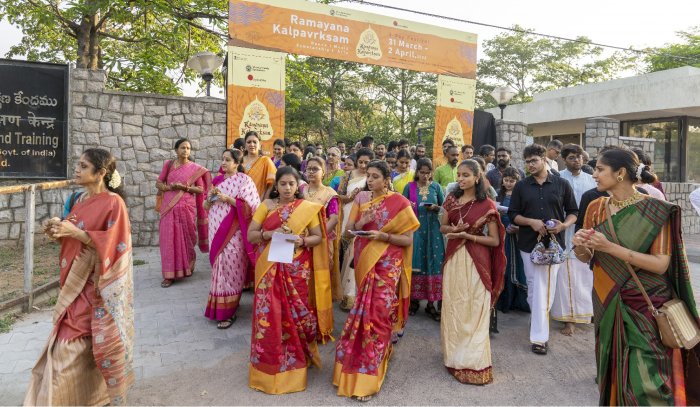 Rama + Ayana Nagara Sankeertana Named after the Telugu masterpiece Ramayana Kalpavrksam (the wish fulfilling tree) composed by Andhra Pradesh's Kavi Samrat and Jnanapith awardee Viswanatha Satyanarayana (1896-1976), the inauguration on the well-packed open grounds of CCRT in Hyderabad, saw the chief guest, honourable Nirmala Sitharaman, open with the statement of Rama + Ayana (ramudu anusirinchina margamu) ,which makes the Ramayana an experience and an immersion by the psyche, an anubhav and not just anvesana. The lustre of this great epic predating the Mahabharata, with references even in Tamil Sangam's Silappadikaram, stems from its legacy of values of perennial contemporaneity, not erased by time. From the arts of story-telling to poetry, music, dance, sculpture, patachitras, puppetry, bronze casting, Yakshagana presentations, Koodiyattam, and what have you, not to speak of foreign incarnations (mentioned by the chief guest) of Ramakien in Thailand, Reamker of Cambodia, Kakowin Ramayana of Indonesia, versions in Laos and Vietnam, in Burma and in Malaysia, this absorbing kavya introduced by Valmiki, explores every type of earthly relationship - between kings and subjects, between brothers - with interactions with tribals, paksis, rakshasas, vanavasins and vanaras - all without fear or favour to any group - which perhaps explains myriad versions of the Ramayana, even across Buddhist, Jain, Christian and Islamic countries. Talking about the therapeutic effects of the Ramayana, Dr. Raghuram, a scholar and Ananda's doctor, the other guest for the evening, explained, how at the height of being challenged by illness, it was losing herself in conducting and curating Krishna Gana Sabha's Natya Kala Conference built round the Ramayana theme, that had proved to pave the way for Ananda's quick recovery. 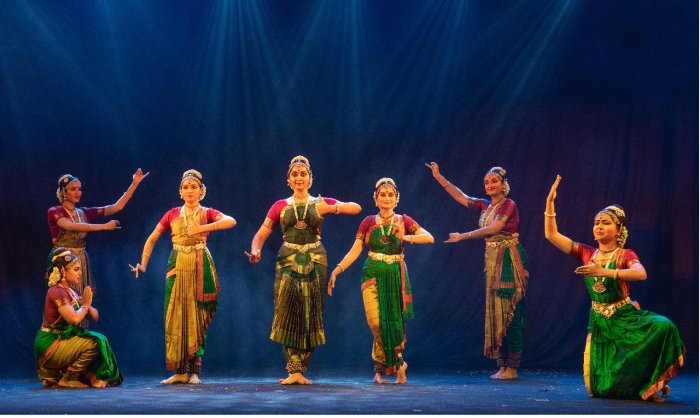 Bhavayami Raghuramam The festival delivered more than it promised, for its crowded programme projected something from all genres of art. After the inauguration by the chief guest, the dance programme, with Kalakshetra's last minute change resulting in their presenting Vitasta, a very short work, which had little connection with the Ramayana, saw Shankarananda Kalakshetra's group presentation of Bhavayami Raghuramam, scheduled for the next evening, being advanced. Despite the last minute stepping in, the group with Shweta Prasad's singing, Ananda Shankar's nattuvangam and mridangam by I.V. Renukaprasad, braving the nth hour, less-than-impeccable sound and light adjustments, did a creditable job. The scheduled presentation the next evening saw the group at its very best, with the audience regaled by what, by any standard, was a flawless rendition. This Sanskrit composition of Swati Tirunal set in one raga in the rupaka talam, was later set in a ragamalika format by Semmangudi Srinivasa Iyer, wherein through ragas Saveri, Nattakuranji, Dhanyasi, Mohanam, Mukhari, Purvikalyani and Madhyamawati, the entire story of the Ramayana unfolds. Presented countless times by Bharatanatyam dancers in particular, with solfa Chitteswaras which are part of the composition, the added punctuation through taut jatis in Ananda's choreography, both in vibrant clarity of nattuvangam, and flawless rhythmic presentation, provided a changeover to another Kandam of the story, also acting as a counter point to the purely narrative part. There is no space in this narration for elaboration and the characters, fleetingly appearing, have to be emphatically outlined. As for the group understanding, the ensemble has never lacked that. The tuneful singing and the dancing excellence with perfect light and sound made for a regaling experience. 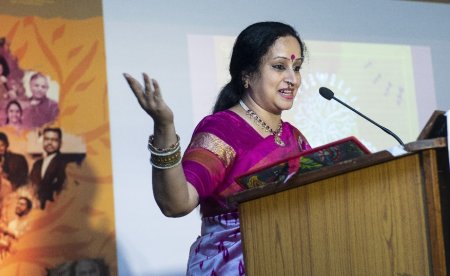 Anupama Kylash The talk sessions provided a peep into a host of Ramayana texts. Full of the subtle and suggestive aesthetics of poetry, Anupama Kylash's pithy introductions for the talk sessions, with selected quotes from Ramayana Kalpavrksam, and other Ramayana texts, set the ball rolling each morning. She gave delightful examples of how the vernacular Ramayanas captured the 'vasana' and flavour of the region of the language - in terms of food, surroundings etc. 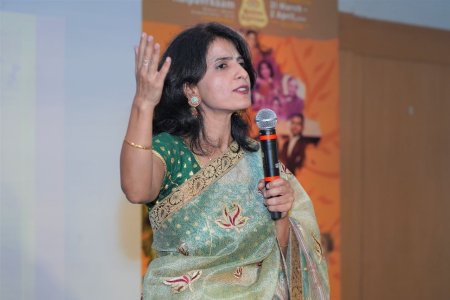 Ami Ganatra Somewhat tantalisingly poised at the edge of the rostrum, with just one half step forward enough to catapult her into space, was Ami Ganatra, passionate in her argument on why, while dealing with the Ramayana, aspects of paapa, prayascit and sankalpa , have to be viewed from different parameters. Rama's killing of Tataki - a female rakshasa - who lawlessly roamed around devouring helpless people, was an act needed for restoring security to the people - the first duty of rajadharma. So too was the stealthy killing of rapist Vali, who had forcefully abducted his brother's wife, an act of restoring justice. Even Mandodari, weeping beside her slain husband's body, acknowledged his death as punishment for wrongfully abducting and imprisoning Sita - a powerful king thus blinded and weakened by his inability to control his senses. 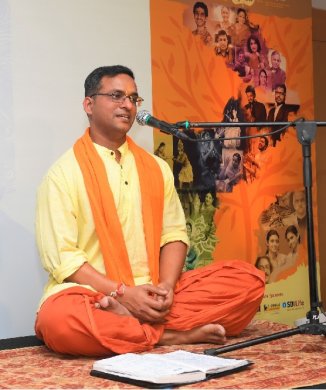 Hemanth Pandey For Hemanth Pandey, the very epitome of bhakti, speaking of Hanumat Darshan based on Valmiki Ramayana, there could be no Rama without Hanuman. After all, if Vishnu agreed to be born as Rama to destroy Ravana, Brahma's protection for him was in asking Shiva to take on the avatar of Hanuman. So close to Rama is he that even Bharata looking at Hanuman remarks, "You look like Sri Rama". Introducing scholar Sudha Sheshayyan, Anupama Kylash referred to the delectable Dhanur bhanga passage in Ramayana Kalpavrksam, where the bow, ready in its tautness to be pulled, when given a slight horizontal bend by Rama, enables him to be able to meet Sita's eyes - and at that moment it breaks. Like special seasoning, every time Anupama introduced a speaker, she touched on rich snippets of poetic delicacy. 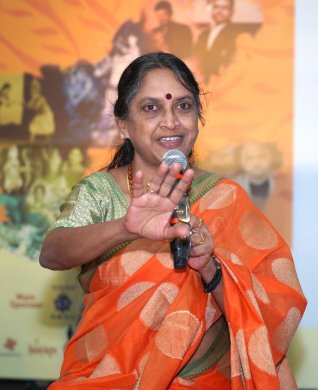 Sudha Seshayyan Sudha Seshayyan in her references to Kamba Ramayanam spoke of poetic articulation in this text dealing with timeless problems. Unlike Aristotelian poetics, the eastern method of moving with chronology has a value based approach - different from the hero/villain dynamics. Vernacular Ramayana versions include a first accidental meeting of Rama and Sita, which is not part of Valmiki's Ramayana. Kamba Ramayanam, while based on Valmiki's Ramayana, is primarily regarded as a Tamil literature classic, coming after the earlier Silappadikaram, Akananoor/Purananoor poems and Pasurams of Alwars. Quoting from Kamba Ramayanam, Sudha Seshayyan described the rich poetic imagery describing the first, accidental face to face, when eyes meet, with Sita looking down from the terrace and Rama, walking outside on the street in Mithila looking up.... "Annalum nokkinan, avalum nokkinal". Pointedly referring to the concluding part of Kamba Ramayanam surrounding the coronation in Ayodhya, the speaker emphasized how while everybody's presence is noted, there is significantly no mention at all of Rama - underlining thereby that it was the establishment and crowning of dharma and not of a person which the occasion marked! 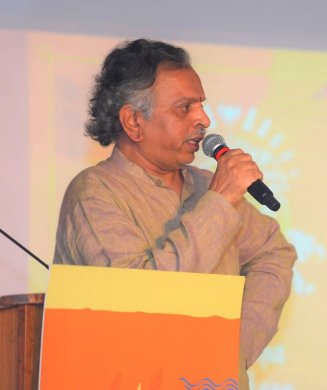 Nagaraj Paturi Another involved talk was by Nagaraj Paturi underlining the Ramayana as a living tradition residing in the collective consciousness of India, rather than in any textual obsession. He blamed the 'Indology' craze introduced by western scholars, who are brought up reading about Greek and Latin gods and goddesses - who are no longer a part of people's belief or worship. They failed to understand that in India, Rama or Hanuman (who for instance is worshipped as the main deity in Rajasthan), far from being pagan worship is a part of the Indian subconscious. So, unlike Sheldon Pollock who spoke of Ramayana as 'othering' and Bharata as 'brothering,' the Ramayana in its inclusive nature with even Hanuman or Guha considered a part of Rama's family, is all about 'brothering'. In one of the vernacular Ramayanas, Kaushalya refers to Guha, the boatman, as the new relative acquired. Political explanations, the speaker said, are sought to be trotted out for the Ayodhya movement - which was a natural expression of the psyche of a people - explaining how even in the remotest villages in India, rituals enacting myth (like Ramlila) has onlookers frequently getting possessed by deities, further closing borders between audience and performance. A Telugu scholar himself, and admirer of poets like Viswanath Satyanarayana, as a cultural anthropologist, Nagaraj Paturi spoke with conviction of our gods and goddesses being the collective unconscious of a people. Referring to marriage, puberty celebrations, and even tribal dances, comprising Kusha/Lava songs, he spoke of Rama living on in the hearts and minds of people. Barring odd statues of Ravana as Panchanga Oduvar in Rama temples, he refuted claims about temples anywhere being dedicated exclusively to Ravana. 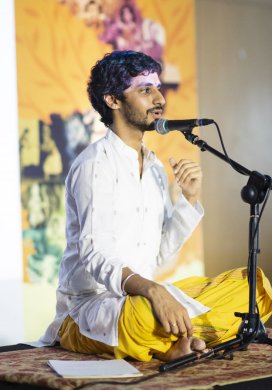 Vinay Varanasi The youngest among scholars, Vinay Varanasi, in a tightly knit, focussed talk on Sita Mahatripurasundari from the Shakta perspective, emerged as one of the most convincing speakers - his statement in tone and substance, chiming in with Anupama Kylash's earlier introduction, pointing to the feisty nature of Telugu heroines (right from Satyabhama) not given to docile submission. Sita undaunted by her lonely incarceration in Ashoka vanam, curses Ravana that her happiness would be only when the Earth God was bathed in his blood. After all, with one look, this Shivashataikyaroopini could have destroyed Ravana, but she waited for the husband to fulfil his duty by rescuing her. Vinay Varanasi began with the declaration that there could be no Ramayana without Sita - for the story, but for Sita, would not have progressed beyond Rama and brothers growing up coddled, amidst the adoring mothers. While even the great Rama had to grow in the mother's womb to be born, Sita had no birth, but was found by Janaka (moolaprakriti viswagarbha) and even Valmiki, a devotee of the Devi, likens winning and attaining Sita as wife, to the awakening of the Kundalini Shakti - after herculean struggles, from the mooladhara to the final chakra of full awakening. Thus it was no wonder that Rama had to break no less than Shiva's Dhanush, before attaining Devi Shakti. No wonder Thyagaraja sang "Ma Janaki chattu petta"(You became great because you held Janaki's hand). It takes superhuman effort by Hanuman in the Sundarakanda, before he locates Mahatripurasundari Sita in Ashoka vana. Almost giving up the search, the realisation dawns on Hanuman that on the locating of Sita rests the future of not just Rama, but the entire Ikshvaku dynasty. And when he finally comes upon the forlorn figure of the Devi in every detail fitting the description given to him by Rama, and he spots missing on her person, those abharanas (ornaments) wrapped in a piece of her clothing, which she had discarded while being abducted, his joy knows no bounds. Reciting copiously from Sanskrit texts describing this Tripurasundari - like the opening line of Lalita Sahasranamam - Srimata, Sri maharagyi, Sreemat Simhasaneswari chit agnikunda sambhoota devakarya samudhyata and from Durga Stuti , the speaker concludes that Sita as Shaiva/Shakti roopena sansthitha is indeed the very incarnation of Devi. It is the Jagat Mata's anger which fuels the fire reducing Lanka to ashes. It is also Sita's deep concern for the fire in Hanuman's tail which makes her, without begging for mercy, address the Gods, that if she has been true to her wifely vows, and if her mind and heart have been suffused with thoughts of Rama, then the heat of the fire should not burn or pain Hanuman. And Hanuman is surprised at the cool feeling on his tail! 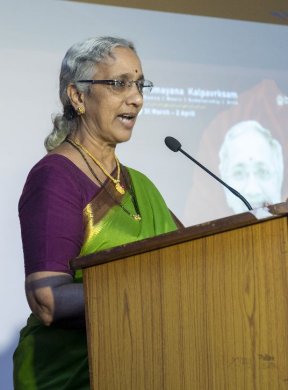 Gauri Mahulikar One of the interesting talks by scholar Gauri Mahulikar threw light on Ramayana versions authored by women, with two examples pertaining to the 16th century - Molla whose work is in Telugu, and Chandrabati who wrote in Bengali. Interestingly, the two came from vastly different levels of society - Molla, a lowly potter's daughter from the village of Gopavaram near Nellore, while Chandrabati was the daughter of a brahmin wandering minstrel. And quite contrary to their origins, the potter's daughter wrote with a punditry, exercising phenomenal control over rhetoric and metres, with a grasp over exquisite erotic imagery. Such unusual talent was totally unexpected in a 16th century woman belonging to a lowly family! Gauri Mahulikar quoting passages from Molla's highly Sanskritic Telugu poetry extolling the manner she played with words - often conveying double meanings - read out one of the examples of the rich imagery in her poetry, pertaining to the description of the sunset beyond the sea, conjuring a picture of a shining sun travelling across the sky the whole day and getting so hot and tired, finally plunging into the ocean to cool himself! Notwithstanding her brahmin origins, Chandravati's Ramayana on the other hand, sans eroticism, again from the 16th century, addressed only women - 'Sakhijane'. Contrary to Rama's adoration, her baromaasi songs revealed a certain disaffection for Rama like "Rama to mar buddhi hoile naas" she says, wondering how he took leave of his senses by leaving Sita alone. These songs, as expressions of Sita's feelings, are a strong part of oral traditions, sung while women work in mills and other places. Strangely, both Molla and Chandrabati were Saivites, and wrote about Rama! 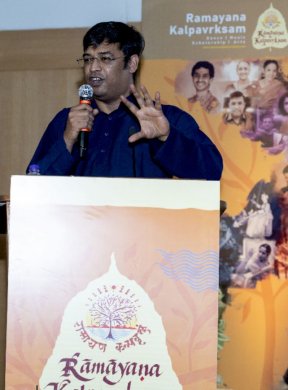 Surjit Dasgupta Among vernacular Ramayanas, Surjit Dasgupta's very voluble talk, which found time constraints difficult to adhere to, on the Bengali Kritibas Ramayana, underlined how this version which predated Tulsidas' Ramayana, had little to do with Ramcharit Manas. Details about Dasaratha's premature coronation, how Jatayu saves him from Sani, how while Kaushalya and Sumitra become his queens through arranged matches, Kaikeyi was won in a swayamvar, how Parasurama coveted Sita for himself and had told Janaka that should he find nobody to break Shiva's bow, Sita was to be given in marriage to him, how Viswamitra discovers that Dasaratha with four totally look-alike sons had cheated him by sending Bharata and Shatrugna rather than Rama and Lakshmana for the mission to destroy Tataki and other demons, and the story of Ganesha where not Shiva but Sani had severed his original head - and much more were all spoken about. Significantly, he mentioned that lakshmana rekha, not mentioned by Valmiki, finds mention in Kritibas Ramayan, which Tulsidas refers to indirectly, when Ravana is cautioned by Mandodari to stay away from fighting Rama - reminding him that he could not even cross three hand drawn lines to enter the hut to abduct Sita! And the speaker stressed the Akal Bodhan invoking of Durga during off season by Rama. Trying to make up for the missing 108th flower needed for the Puja by offering his lotus eyes instead, he is stopped by the Devi with the promise that victory in battle will be his. 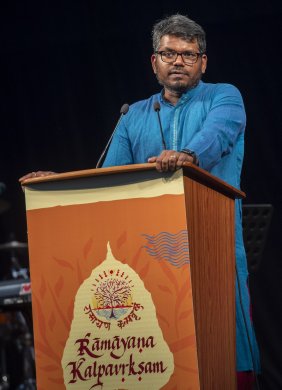 Sai Deepak Any discussion on the Ramayana leads inevitably to the topic of Raja Dharma. Dharma, a loaded term, embraces almost all aspects of a person's role in society. Sai Deepak, engineer-turned-litigator practising as an arguing counsel primarily before the Supreme Court, discussed the question before a large audience on the open lawns. To what extent can a present secular system separating religion from State, so different from the civilizational experience of temple as centre of satva, keeping rajas and tamas in check, with Rama enforcing order through the instrumentality of the State, accommodate what one finds in the Ramayana? 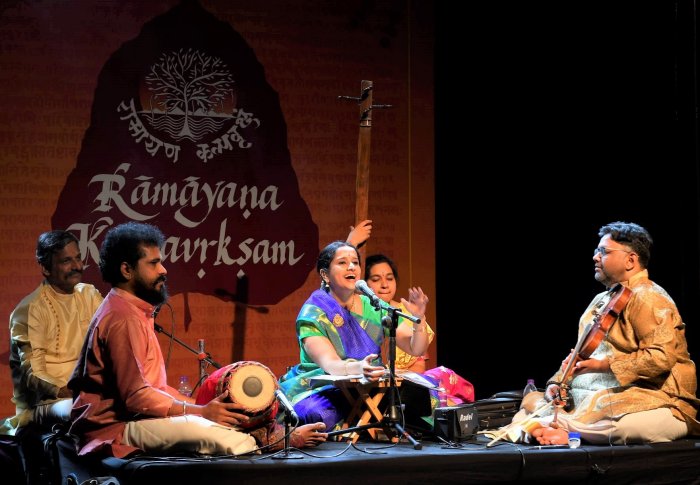 Vishaka Hari The Harikatha presentation Navarasa Ramayana by Vishaka Hari was an experience in itself. With her erudition, combined with the eloquence in story- telling, not to speak of the lilting musical ability honed by long years of training under that musical stalwart Lalgudi Jayaraman, her Harikatha exudes rare conviction. From one who combines so many talents, her address before a mixed audience about the many artistic flavours or rasikatwa in the Ramayana, had an individualistic touch. Vishaka Hari enables one to look at the Ramayana through eyes which see what is not visible to the common man, through 'fiction as facts and facts as fiction.' Following a rendition of Thyagaraja's Sogasugamridanga talamu in Sriranjini on the ecstasy of the nine rasas sung in perfect prosody and rhythms, she deals with episodes extolling various rasas in the Ramayana - her approach very different from the usual. She sees sringaram not in the joys of Sita being won in the Swayamvara, but in the joys of optimism of Rama and Sita in the forest when, far from the expected coronation of Rama, and sans any of the comforts of palace living, the couple finds joy in togetherness amidst nature. Similarly bhayam is felt in Sita's fears, on seeing such a slender young prince like Rama stepping forward to break such a mighty bow, which even many of the seemingly strong have failed to accomplish. As the bow breaks, Sita's fears vanish. Similarly Rama's feeling of bhibhatsa or disgust during the killing of Tataka is directed against himself - the fulfilling of the commands of Viswamitra making him commit nari vad - which goes totally against his exalted feeling of righteousness. Rama's karunya or sorrow is when he is deprived of Sita. Tranquillity (shanti) cannot be acquired through wrongfully gained prosperity, and not surprisingly Bharata has no peace after being anointed King, "Shantamu ledu saukhyamu ledu" (neither peace nor tranquillity) goes the famous Keertanam. Peace comes only with Paduka Pattabhishekham when Rama's footwear adorns the throne. Setu bandhan is universally accepted as the quintessence of arbhutam or wonderment. But even here Vishaka Hari looks at the picture differently. According to her Guru, the greatest wonder lay in Rama, with all the power at his command, showing such respect for the rule of nature, waiting patiently for the Samudra Raja to give permission to build a bridge to cross over to Lanka. The plethora of ragas, the delightful violin and mridangam accompaniment, the special effects produced through solfa passage interventions or phrases of tillana punctuations, made for a vibrant presentation, holding the audience spellbound. MUSIC Music performances based on the Ramayana took on various forms. Rendering the Pancharatna Kritis in traditional Carnatic style were Shweta Prasad and group.  Nagara Sankeertana One of the very unique musical events this writer unfortunately missed, was an early morning public walk Rama Ayana (travels of Rama), with Nagara Sankeertana covering certain areas of the city, led by T.K. Saroja and T.K. Sujatha. 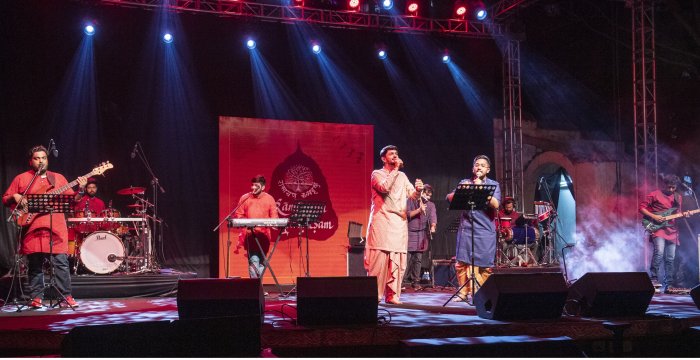 Taaraka Nama Taaraka Nama, fusion music by Abhilash Venkitachalam and Sai Vighnesh, provided another captivating session. The fine Ramayana centred compositions rendered by trained singing voices, with instruments like the guitar and accordion and percussion providing accompaniment, began in Kadanakutoohalam, with a zippy Raghuvamsha sudhambudhi chandra sri, a composition in Sanskrit by Patnam Subramani Iyer. A number of compositions followed - a Meera Bhajan "Ram ratan dhan payo", Tyagaraja's "Rama nannu brovara" in Harikambodhi, the devotional Tirumala Tirupati Devasthanam song of Annamacharya, "Adivo Sri Hari vaasamu" in Hindolam, "Sri Rangapuravihara", Muthuswamy Dikshitar's composition in Brindavana saranga, "Pantureetikolu viyavaiya Rama" in Hamsanandam and so on. With the fusion instrumentation, the entire treatment acquires a quality of energy which is infectious, making even those who would consider austere Carnatic classical fare beyond their understanding getting involved - clapping, dancing and jumping to the music. 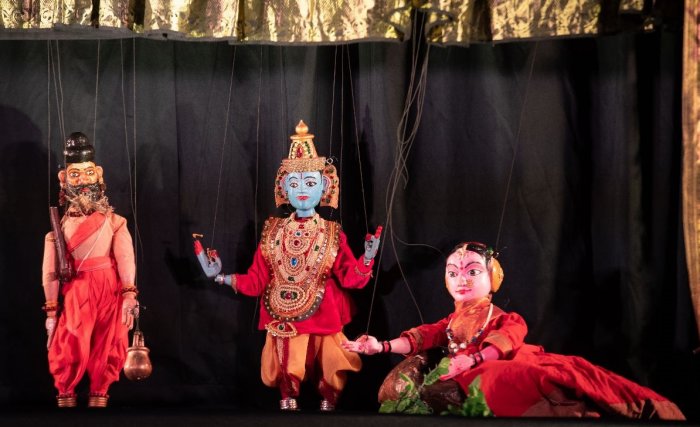 Dhaatu Puppet Theatre In what was a maiden performance of this group of string puppetry in Hyderabad, Anupama Hoskere's very colourful Dhaatu Puppet Theatre based on Valmiki Ramayana, in a ceremonial start, began with homage to the poet "Vande Valmiki Kokilam''. String puppets manipulated skilfully, with a carefully worked out script and tunefully rendered music, comprised many languages in the dialogue - Hindi, Marathi, Telugu, Kannada and even a Manthara conversing and poisoning Kaikeyi's mind in English! Dasaratha with the three queens in the Putrakameshti scene, Laali sung with the babies in the cradle, Thumakchalat Ramachandra showing little Rama taking hesitant first steps and Shoorpanaka approaching the princes in Panchavati, were all part of the projection. It was interesting to see the elaborate costumes for Rama and Sita. 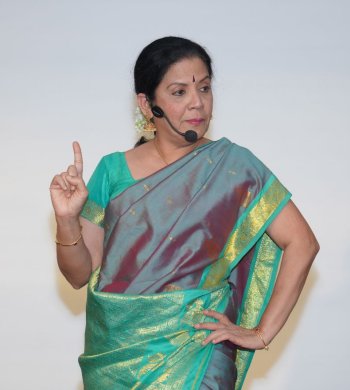 Ramaa Bharadvaj Dancer, humourist, story teller, author, scholar and researcher who spent 31 years in the United States, Ramaa Bharadvaj regaled the audience with a spirited recounting of Ramayana away from the Desi, with the kind of twists and turns the story has taken in the many countries it has travelled to. The secret of its relevance is in how each retelling has recontextualised itself to the culture of that place - in China, in Tibet, in Japan, in Southern Java, and in Sumatra, Malaysia, Eastern Burma, Thailand and Laos. Ramaa began with her own experience in the United States of a native American Shaman woman who made it out of bounds for anybody to step into a certain area in her backyard, where she believed Rama had stood! The Ramayana characters are seen in tortuous relationships and one can only marvel at the kind of changes the story has lent itself to, with a strong Buddhism with Hinduism mix in some places. In Indonesia, Sita is called Rekhya, or Sinta is Ravana's own biological daughter! Javanese Ramayana believes that Rama's coronation is not in Ayodhya but a new kingdom Rama built in Panchavati. In Malaysia's Hikayat Seri Rama, Lakshmana is given a bigger role than Rama. As for the character of chaste Hanuman, he is treated variously by different Ramayana versions - often a colourful character very different from the brahmachari of Indian Ramayana. Indonesian Sita is a strong woman who fights her own battles. The Ramakien is part of National Broadcasting of Thailand, Rama still used for kings as prefix or suffix. In Malaysia to this day, the idea of 'Lakshmana rekha' is present. Apart from the narrative details, Ramaa's presentation, with her own considerable histrionic ability for storytelling, made for entertainment. 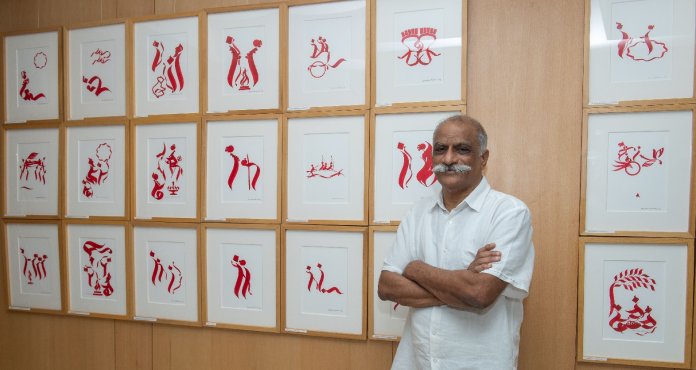 Parameshwar Raju 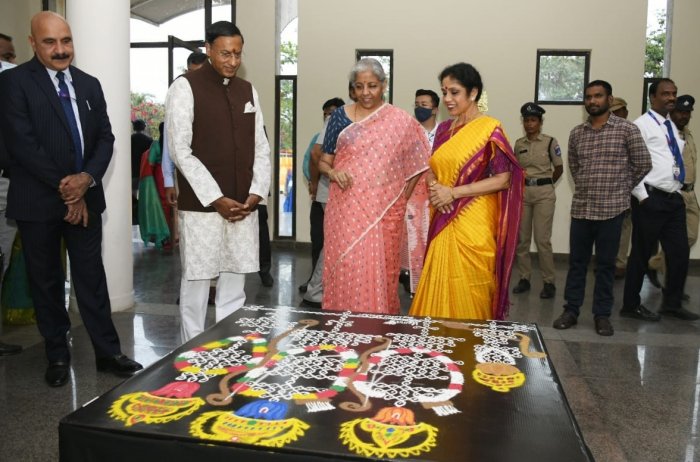 Appreciating the Sri Rama Pattabhishekam kolam by Hema Kannan Workshops with enthusiasts registering pertained to Kolam work (Chitra Kaushalya) by Hema Kannan which attracted a sizeable number of volunteers and Mala Grantham, making of garlands for the gods, under Rahul Teddy. The pictorial calligraphy exhibition on the Ramayana by artist Parameshwar Raju in a hall on the first floor was one of its kind. He uses a kind of metallic ink to prevent smudging. And to watch him create within the space of half a minute a drawing of Rama and Lakshmana seated each with arrow in hand, with Sita seated in the centre and with just a line with two curved lines below, convey the image of an entire boat being rowed by Guha seated at the end, left me spellbound. Here was a most gifted artist at work. The entire wall on four sides of the large room was filled with drawings of various scenes from the Ramayana. The totally unassuming simplicity of the man for me, was the highest example of what 'ramatvam' means. In a phenomenal event planned with meticulous care, there was also an artisan's corner with some stalls exhibiting handicrafts. In what was an endless array of activities and experiences, limits were dictated by each visitor's capacity to take in.  Writing on the dance scene for the last forty years, Leela Venkataraman's incisive comments on performances of all dance forms, participation in dance discussions both in India and abroad, and as a regular contributor to Hindu Friday Review, journals like Sruti and Nartanam, makes her voice respected for its balanced critiquing. She is the author of several books like Indian Classical dance: Tradition in Transition, Classical Dance in India and Indian Classical dance: The Renaissance and Beyond. Post your comments Pl provide your name and email id along with your comment. All appropriate comments posted with name and email id in the blog will also be featured in the site. |